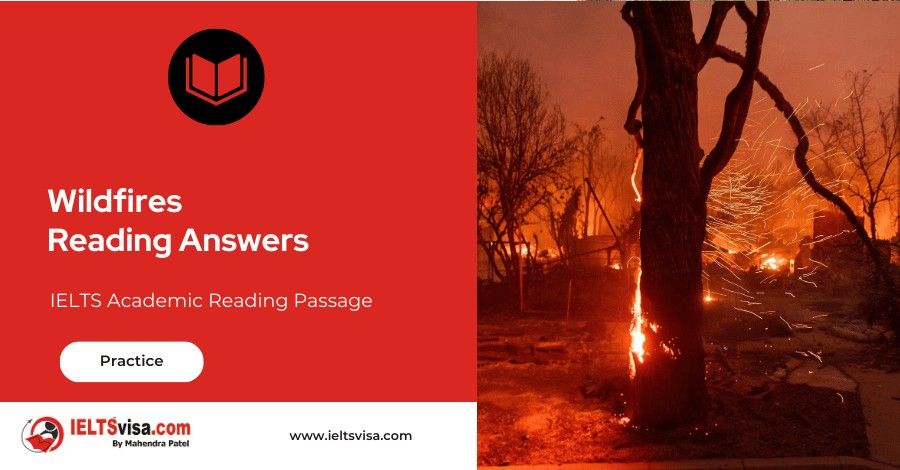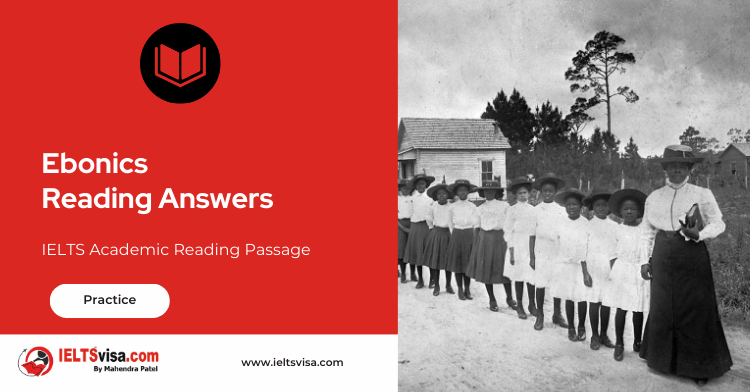Wildfires Reading Answers
IELTS Academic Reading Passage
A Wildfires are usually the product of human negligence Humans start about 90% Of Wild fires and lightning causes the other 10%. Regular causes for Wildfires include arson, camping fires, throwing away cigarettes, burning rubbish, and playing with fireworks or matches. Once begun, wildfires can spread at a rate of up to 23 kph and, as a fire spreads over a landscape, it could undertake a life of its own — doing different things to keep itself going, even creating other blazes by throwing cinders miles away.
Three components are necessary to start a fire: oxygen, fuel and heat. These three make up “the fire triangle” and fire fighters frequently talk about this when they are attempting to put out blazes. The theory is that if the fire fighters can remove one of the triangle pillars, they can take control of and eventually put out the fire.
B The speed at which wildfires spread depends on the fuel around them. Fuel is any living or dead material that will burn. Types Of fuel include anything from trees, underbrush and grassland to houses. The quantity of inflammable material around a fire is known as “the fuel load” and is determined by the amount of available fuel per unit area, usually tons per acre. How dry the fuel is can also influence how fires behave. When the fuel is very dry, it burns much more quickly and forms fires that are much harder to control.
Basic fuel characteristics affecting a fire are size and arrangement and moisture, but with Wildfires, where fuel usually consists Of the same type Of material, the main factor influencing ignition time is the ratio Of the fuel’s total surface area to its volume. Because the surface area Of a twig is not much bigger than its volume, it ignites rapidly. However, a tree’s surface area is much smaller than its volume, so it requires more time to heat up before ignition.
C Three weather variables that affect wildfires are temperature, wind and moisture. Temperature directly influences the sparking Of Wildfires, as heat is one Of the three pillars Of the fire triangle. Sticks, trees and underbrush on the ground receive heat from the sun, Which heats and dries these potential fuels. Higher temperatures allow fuels to ignite and burn more quickly and add to the speed Of a Wildfire’s spread Consequently, Wildfires tend to rage in the afternoon, during the hottest temperatures.
The biggest influence on a wildfire is probably wind and this is also the most unpredictable variable. Winds provide fires with extra oxygen, more dry fuel, and wind also makes wildfires spread more quickly. Fires also create winds Of their own that can be up to ten times faster than the ambient Wind. Winds can even spread embers that can generate additional fires, an event known as spotting. Winds also change the course Of fires, and gusts can take flames into trees, starting a “crown fire”. Humidity and precipitation provide moisture that can slow fires down and reduce their intensity, as it is hard for fuel to ignite if it has high moisture levels. Higher levels of humidity mean fewer wildfires.
D Topography can also hugely influence wildfire behavior. In contrast to fuel and weather, topography hardly changes over time and can help or hamper the spread of a wildfire. The principal topographical factor relating to wildfires is slope. AS a rule, fires move uphill much faster than downhill and the steeper the slope, the quicker fires move. This is because fires move in the same direction Of the ambient wind, which generally blows uphill. Moreover, the fire can preheat fuel further uphill as smoke and heat rise in that direction. On the other hand, when the fire reaches the top Of a hill, it has to struggle to come back down.
E Each year thousands of fire fighters risk their lives in their jobs. Elite fire fighters come in two categories: Hotshots and Smokejumpers. Operating in 20 man units, the key task of hotshots is to construct firebreaks around fires. A firebreak is a strip of land with all potential fuel removed. As their name suggests, smokejumpers jump out of aircraft to reach smaller fires situated in inaccessible regions. They attempt to contain these smaller fires before they turn into bigger ones.
As well as constructing firebreaks and putting water and fire retardant on fires, fire fighters also use “backfires”. Backfires are created by fire fighters and burn towards the main fire incinerating any potential fuel in its path. Fire fighters on the ground also receive extensive support from the air with tankers dropping thousands of gallons of water and retardant. Dropped from planes and helicopters, retardant is a red chemical containing phosphate fertilizer, which slows and cools fires.
Questions 1-4
Reading Passage I has 5 paragraphs (A — E). From the list of headings below choose the most suitable headings for paragraphs B — E. Write the appropriate number (i — viii) in boxes I — 4 on your answer sheet.
NB There are more headings than paragraphs, so you will not use them all.
Example Paragraph A
List of headings
i Climate Conditions
ii Solutions from the Air
iii Fire Starters
iv Battling the Blaze
v The Lie of the Land
vi Rain — The Natural Saviour
Vii Fuelling the Flames
Viii Fires and Trees
I Paragraph B
2 Paragraph C
3 Paragraph D
4 Paragraph E
Questions 5—9
Using NO MORE THAN THREE WORDS from Reading passage 2, answer the following questions. Write your answers in boxes 5- 9 on your answer sheet.

6 What is measured in tons per acre?
7 When do wildfires burn at their fiercest?
8 What can travel in the wind to create fires at some distance from the initial fire?
9 Name a method using an additional fire that fire fighters use to control wild fires.
Questions 10-13
Complete each of the following statements (Questions 10 — 13) with words taken from Reading
Passage 1.
Write NO MORE THAN THREE WORDS for Each answer.
10 The most important factor in how quickly a Wildfire catches fire is the surface to volume ………….
11 The most significant weather factor to affect wildfires’ actions is ………………..
12 Fires on the tops of trees are known as ………………………
13 Wildfires usually travel much faster ……………………… because of the typical direction of prevailing winds.

Solution For: Wildfires
Reading Answers
| 1 – vii | 8 – Embers |
| 2 – i | 9 – backfire(s) |
| 3 – v | 10 – ratio (of fuel) |
| 4 – iv | 11 – the wind |
| 5 – air/oxygen | 12 – crown fire |
| 6 – the fuel load | 13 – uphill |
| 7 – In the afternoon |
Review and Practice
- Regularly practice with IELTS reading samples and time yourself to get used to the pressure of the exam.
- Review your mistakes to understand where you went wrong and how to avoid similar errors in the future.
Our Books
Master IELTS Speaking Part 1
IELTS Writing Task 1 Book
IELTS Writing Task 2 Book
Wildfires Reading Answers Explanation
Comin Soon
Practice IELTS Other Modules
IELTS Listening
The IELTS Listening test assesses how well you can understand spoken English in various contexts. It lasts about 30 minutes and is divided into four sections with a total of 40 questions. The listening tasks become increasingly difficult as the test progresses.
IELTS Academic Reading
The IELTS Academic Reading section assesses your ability to understand and interpret a variety of texts in academic settings. It is designed to evaluate a range of reading skills, including skimming for gist, reading for main ideas, reading for detail, understanding inferences, and recognizing a writer's opinions and arguments.
IELTS Speaking
The IELTS Speaking test assesses your ability to communicate in English on everyday topics. It lasts 11-14 minutes and consists of three parts: introduction, cue card, and a discussion based on the cue card topic.
IELTS General Reading
IELTS General Reading tests your ability to understand and interpret various types of texts. Here are some key areas and types of content you can expect to encounter in the reading section, along with tips for effective preparation.
IELTS Academic Writing Task 1
In IELTS Academic Writing Task 1, you are presented with a visual representation of information, such as graphs, charts, tables, or diagrams, and you are required to summarize, compare, or explain the data in your own words.
IELTS General Writing Task 1
In IELTS General Writing Task 1, you are required to write a letter based on a given situation. The letter can be formal, semi-formal, or informal, depending on the prompt. Here’s a breakdown of the key components to include in your letter
IELTS Academic Writing Task 2
In IELTS Academic Writing Task 2, you are required to write an essay in response to a question or topic. Here’s a guide to help you understand the essential elements of this task
IELTS Exam Tips
To succeed in the IELTS exam, practice regularly, familiarize yourself with the test format, improve your vocabulary, develop time management skills, and take mock tests to build confidence.
Grammer for IELTS
Grammar is the foundation of effective communication in English. Understanding tense usage, subject-verb agreement, and sentence structure enhances clarity and coherence in writing and speaking.
Vocabulary for IELTS
Vocabulary plays a crucial role in the IELTS (International English Language Testing System) exam, especially in the Speaking and Writing sections. Here’s an overview of why vocabulary is important and how it impacts your performance
RECENT IELTS SAMPLES QUESTIONS AND ANSWERS
Ebonics Reading Answers
A. Ebonics - also known by a host of other names such as African American Vernacular English,...
A Disaster Of Titanic Proportions
A. At 11:39 p.m. on the evening of Sunday, 14 April 1912, lookouts Frederick Fleet and...
Vitamins To supplement or not?
Mineral, vitamin, and antioxidant health supplements make up a multi-billion-dollar industry...
The Hollywood film industry
A. This chapter examines the ‘Golden Age’ of the Hollywood film studio system and explores how...
Three Dimensional Films Reading Answers
A. In the theatre of the Ambassador Hotel in Los Angeles, on the evening of 27 September 1922,...
The Developing World Reading Answers
A THE DEVELOPING WORLD — the economically underdeveloped countries of Asia. Africa. Oceania...













